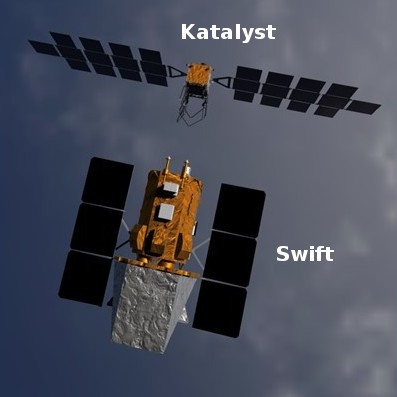Katalyst picks Northrop Grumman’s Pegasus rocket to launch its Swift rescue mission

Katalyst’s proposed Swift rescue mission.
Click for original image.
The orbital repair startup Katalyst yesterday announced it has chosen Northrop Grumman’s air-launched Pegasus rocket to launch its mission to rescue NASA Gehrels-Swift space telescope.
Unlike typical launch campaigns that take up to 24 months, Katalyst has under eight months to get its LINK spacecraft on orbit to rescue Swift. Swift’s orbital decay demands an urgent mission, launching before atmospheric drag makes recovery impossible. Pegasus is the only system that can meet the orbit, timeline, and budget simultaneously.
Swift’s orbit at 20.6° inclination is difficult to reach from U.S. launch sites, where most small rockets are limited by launch site to inclinations above ~27°. Pegasus, carried aloft by Northrop Grumman’s L-1011 Stargazer aircraft and released midair at 39,000 feet, offers the flexibility to launch from virtually anywhere on Earth, making it one of the few viable systems capable of achieving Swift’s orbit on a highly compressed timeline.
This plan has numerous unusual aspects. First, the decision by NASA in September 2025 to pick Katalyst was a surprise. The company is new, and has never actually flown a repair mission yet. It got the contract basically because it could quickly reshape its first planned demo mission into a Swift repair mission.
Second, Pegasus was originally created in the 1980s as a low-cost rocket by the company Orbital Sciences (now part of Northrop Grumman). Though it initially undercut the prices of the existing rocket companies, in the long run it failed to offer a viable option. It hasn’t launched in almost five years, and has only been used five times in the past sixteen years. Northrop Grumman stopped making it years ago, and presently only has this one last rocket in its warehouse.
Finally, saving Gehrels-Swift is critical. It has been one of NASA’s most successful relatively low-cost space telescopes, designed to quickly target high energetic events like gamma ray bursts in order to capture the optical component of the blast. Its orbit is fast decaying and if not raised it will burn up in the atmosphere by 2029. To save it however requires a unique and improvised solution as it has no grapple attachment. Katalyst’s rescue spacecraft ““will rely on a custom-built robotic capture mechanism that will attach to a feature on the satellite’s main structure–without damaging sensitive instruments.”
To put it mildly, in many ways this might be one of the most daring NASA missions ever flown.

Katalyst’s proposed Swift rescue mission.
Click for original image.
The orbital repair startup Katalyst yesterday announced it has chosen Northrop Grumman’s air-launched Pegasus rocket to launch its mission to rescue NASA Gehrels-Swift space telescope.
Unlike typical launch campaigns that take up to 24 months, Katalyst has under eight months to get its LINK spacecraft on orbit to rescue Swift. Swift’s orbital decay demands an urgent mission, launching before atmospheric drag makes recovery impossible. Pegasus is the only system that can meet the orbit, timeline, and budget simultaneously.
Swift’s orbit at 20.6° inclination is difficult to reach from U.S. launch sites, where most small rockets are limited by launch site to inclinations above ~27°. Pegasus, carried aloft by Northrop Grumman’s L-1011 Stargazer aircraft and released midair at 39,000 feet, offers the flexibility to launch from virtually anywhere on Earth, making it one of the few viable systems capable of achieving Swift’s orbit on a highly compressed timeline.
This plan has numerous unusual aspects. First, the decision by NASA in September 2025 to pick Katalyst was a surprise. The company is new, and has never actually flown a repair mission yet. It got the contract basically because it could quickly reshape its first planned demo mission into a Swift repair mission.
Second, Pegasus was originally created in the 1980s as a low-cost rocket by the company Orbital Sciences (now part of Northrop Grumman). Though it initially undercut the prices of the existing rocket companies, in the long run it failed to offer a viable option. It hasn’t launched in almost five years, and has only been used five times in the past sixteen years. Northrop Grumman stopped making it years ago, and presently only has this one last rocket in its warehouse.
Finally, saving Gehrels-Swift is critical. It has been one of NASA’s most successful relatively low-cost space telescopes, designed to quickly target high energetic events like gamma ray bursts in order to capture the optical component of the blast. Its orbit is fast decaying and if not raised it will burn up in the atmosphere by 2029. To save it however requires a unique and improvised solution as it has no grapple attachment. Katalyst’s rescue spacecraft ““will rely on a custom-built robotic capture mechanism that will attach to a feature on the satellite’s main structure–without damaging sensitive instruments.”
To put it mildly, in many ways this might be one of the most daring NASA missions ever flown.
